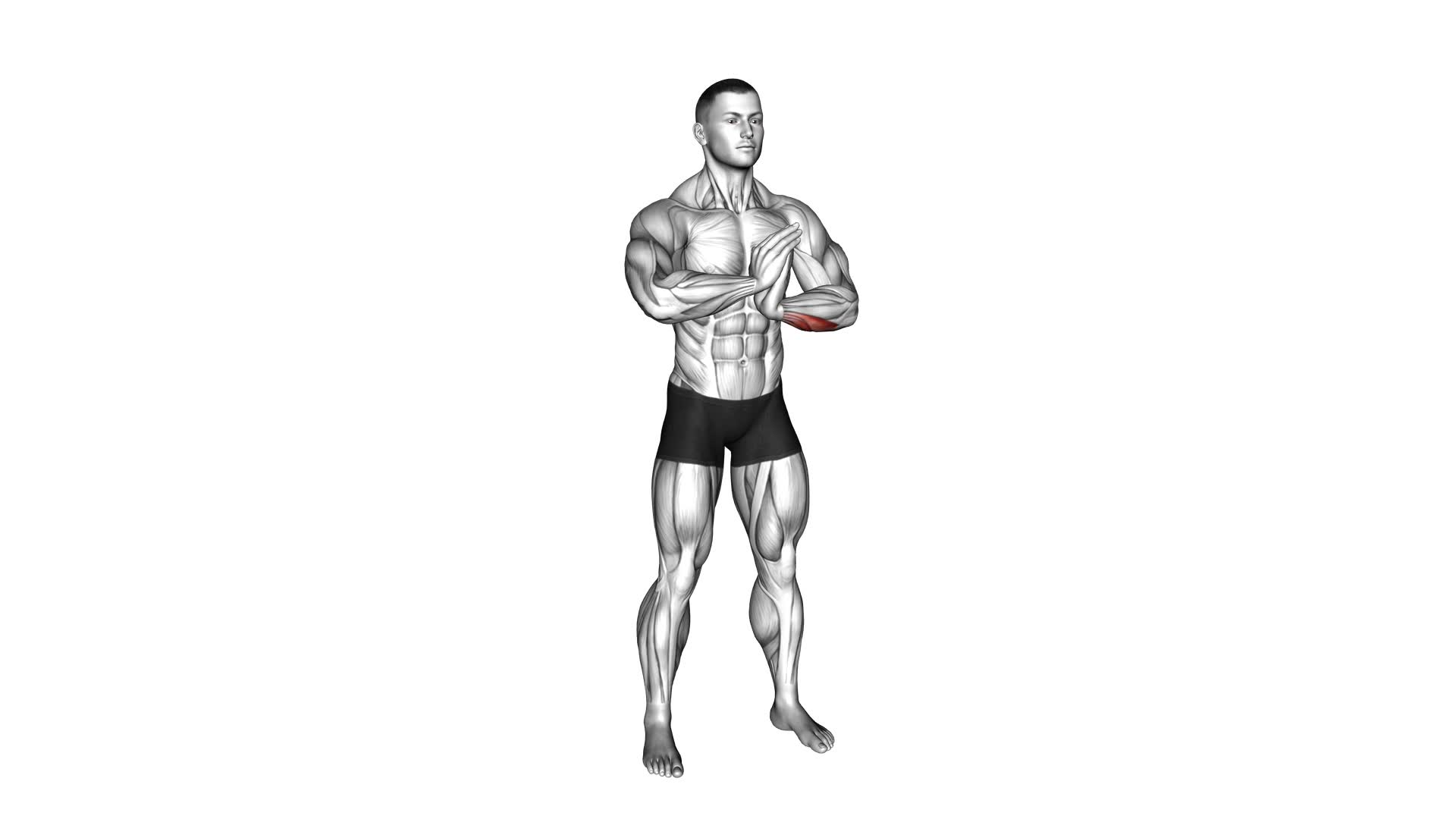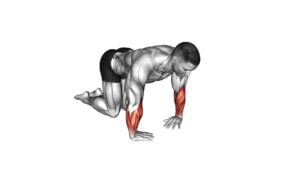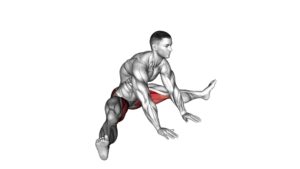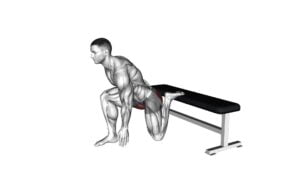Finger Flexor Stretch – Video Exercise Guide & Tips

Are your fingers feeling tight and tense?
Watch This Exercise Video
In this video exercise guide, we'll show you how to do the finger flexor stretch to relieve tension and improve flexibility.
You'll learn the proper form and technique, as well as modifications for different fitness levels.
Avoid common mistakes and get tips for incorporating this stretch into your routine.
Get ready to give your fingers the stretch they need for optimal health and performance.
Let's get started!
Key Takeaways
- The finger flexor stretch targets muscles in the fingers and hands, improving flexibility and reducing stiffness.
- Regular stretching of the finger flexor muscles can alleviate symptoms of arthritis and carpal tunnel syndrome.
- This stretch increases blood flow and promotes healthier joints in the hands.
- Proper form and technique, as well as maintaining proper alignment, are crucial for maximizing the benefits of the finger flexor stretch and preventing injuries.
Benefits of the Finger Flexor Stretch
You can experience several benefits from regularly performing the Finger Flexor Stretch. This stretch targets the muscles in your fingers and hands, helping to improve flexibility and reduce stiffness. One of the key benefits of this stretch is that it can help alleviate the symptoms of conditions such as arthritis and carpal tunnel syndrome. By regularly stretching your finger flexor muscles, you can increase blood flow and promote healthier joints in your hands.
Proper hand positioning is crucial when performing the Finger Flexor Stretch. To begin, extend your arm in front of you with your palm facing up. Gently curl your fingers towards your palm, using your other hand to assist if needed. Hold this position for 15-30 seconds, feeling a gentle stretch in your fingers and hand. Remember to breathe deeply and relax your muscles as you perform the stretch.
It's important to note that variations of the Finger Flexor Stretch can be done to accommodate different hand sizes. If you have larger hands, you can use a towel or resistance band to assist with the stretch. Simply wrap the towel or band around your fingers and gently pull towards your palm. This will provide a deeper stretch for your finger flexor muscles.
Incorporating the Finger Flexor Stretch into your regular exercise routine can help improve hand and finger dexterity, reduce stiffness, and promote healthier joints. Practice proper hand positioning and consider variations for different hand sizes to make the most of this stretch.
Proper Form and Technique
To perform the finger flexor stretch with proper form and technique, start by ensuring correct hand placement. Place your palm flat against a wall or surface, with fingers spread wide and pointing upwards.
This position will help you avoid wrist strain and maintain proper alignment throughout the stretch.
Correct Hand Placement
Place your hand with precision and proper form to ensure correct hand placement during the finger flexor stretch. Proper hand placement is crucial for targeting the finger flexor muscles effectively and minimizing the risk of injury.
There are different hand placement variations you can try to vary the intensity of the stretch and target different areas of the finger flexors. One common hand placement variation is to place your hand flat on a table or other surface, fingers extended and spread apart.
Another variation is to interlace your fingers and gently press your palms together, creating a stretch through the entire hand and fingers. Experiment with different hand placements to find the one that feels most effective for you.
Remember to maintain proper form throughout the exercise to maximize its benefits and minimize the risk of strain or injury.
Avoid Wrist Strain
Maintain proper form and technique to avoid wrist strain during the finger flexor stretch. To prevent wrist injuries and promote wrist flexibility, follow these guidelines:
- Keep your wrist in a neutral position throughout the exercise. Avoid excessive flexion or extension, as this can strain the tendons and ligaments.
- Engage your core and maintain good posture to distribute the load evenly and reduce strain on the wrists.
- Start with gentle stretches and gradually increase the intensity over time. Listen to your body and avoid pushing beyond your limits.
- If you experience any pain or discomfort in your wrists, modify the exercise or consult a healthcare professional for guidance.
By following these tips, you can protect your wrists and maximize the benefits of the finger flexor stretch.
Now, let's transition into the next section, which focuses on maintaining proper alignment for optimal results.
Maintain Proper Alignment
Make sure you're in the correct position for optimal results by aligning your body and maintaining proper form and technique during the finger flexor stretch. Maintaining alignment is crucial to preventing injuries and getting the most out of this exercise.
To do this, start by sitting up straight with your back supported and your feet flat on the floor. Keep your shoulders relaxed and your neck aligned with your spine.
As you perform the stretch, pay attention to your wrist and hand positioning. Make sure your wrist is straight and your fingers are extended and spread apart. This will help target the finger flexor muscles effectively and reduce the risk of strain or injury.
Now that you know how to maintain proper alignment, let's move on to the equipment needed for the exercise.
Equipment Needed for the Exercise
Now let's talk about the essential equipment you'll need for the Finger Flexor Stretch exercise. Don't worry, you won't need any fancy or expensive gear. Affordable options like resistance bands or even a simple towel can be used to effectively stretch your finger flexors.
And if you don't have access to these, don't fret, as there are alternative exercises that can help you achieve similar results without any equipment at all.
Essential Equipment for Exercise
You will need three essential pieces of equipment for this exercise. Here are the exercise accessories you'll need:
- Resistance Band: A resistance band will provide the necessary tension to stretch your finger flexors effectively. Choose a band with the appropriate resistance level for your fitness level.
- Yoga Mat: A yoga mat will provide cushioning and support for your body during the exercise. It will also help prevent slipping and provide a comfortable surface to perform the finger flexor stretch.
- Towel: A towel can be used to enhance the stretch by adding resistance. You can place the towel under your foot and hold onto it with your hand to intensify the stretch.
- Water Bottle: Staying hydrated is essential during any exercise routine. Make sure to have a water bottle nearby to keep yourself hydrated throughout the workout.
Affordable Options for Equipment
To find affordable options for the equipment needed for the finger flexor stretch, consider looking for equipment alternatives that won't break the bank. There are several affordable options available that can help you achieve the desired stretch without spending a fortune.
One option is to use a resistance band, which is inexpensive and can provide the necessary resistance to stretch your finger flexors effectively.
Another affordable alternative is to use a towel or a small cloth to perform the stretch. Simply wrap the towel or cloth around your fingers and gently pull for a deep stretch.
By exploring these affordable options, you can save money while still reaping the benefits of the finger flexor stretch.
Now, let's move on to discuss alternatives to expensive equipment.
Alternatives to Expensive Equipment
Consider exploring cost-effective options for the equipment needed for the finger flexor stretch to save money while still achieving the desired results. Here are four alternatives to expensive equipment that you can consider for your DIY home gym or homemade exercise equipment:
- Resistance Bands: These versatile and affordable bands can provide the necessary resistance for the finger flexor stretch. They come in different levels of resistance, allowing you to gradually increase the intensity of your workout.
- Tennis Ball: A simple tennis ball can be used to target and stretch the finger flexors. By squeezing the ball in your hand, you engage the muscles and improve flexibility.
- Hand Grippers: Hand grippers are small and inexpensive tools that help strengthen the finger and hand muscles. They provide resistance when squeezed, making them an effective alternative for the finger flexor stretch.
- Towel: A towel can be rolled up and used to perform finger stretches. By gripping the towel and pulling it towards you, you engage the finger flexor muscles and improve flexibility.
Exploring these cost-effective options allows you to save money while still achieving the desired results.
Now, let's move on to discussing modifications for different fitness levels.
Modifications for Different Fitness Levels
Adjustments can be made to accommodate various fitness levels while performing the finger flexor stretch. One way to modify the stretch is by using different hand positions.
For beginners, it's recommended to start with a basic hand position, where the fingers are extended and the palm is facing down. This position provides a gentle stretch to the finger flexors.
As you progress, you can try more advanced hand positions, such as the hook grip or the prayer grip. These positions increase the intensity of the stretch and target different muscles in the hand and forearm.
Another modification for different fitness levels is to incorporate progression exercises. Beginners can start with a static hold, where you simply hold the stretch for a certain amount of time.
As you become more comfortable, you can add movement by flexing and extending the fingers while holding the stretch. This dynamic movement helps to improve flexibility and strength in the finger flexors.
Remember to listen to your body and only push yourself to a level that feels comfortable. By making these adjustments, you can tailor the finger flexor stretch to your specific fitness level and goals.
Common Mistakes to Avoid
One common mistake to avoid when performing the finger flexor stretch is gripping too tightly. While it may be tempting to exert force and pull your fingers back forcefully, doing so can lead to wrist strain and potential injury.
To ensure you perform the finger flexor stretch correctly and avoid common mistakes, keep the following tips in mind:
- Relax your hand: It's important to keep your hand and fingers relaxed throughout the stretch. Avoid tensing up or clenching your fist, as this can put unnecessary strain on your wrist.
- Use gentle pressure: Instead of forcefully pulling your fingers back, apply gentle pressure to stretch your finger flexors. Gradually increase the pressure as you feel comfortable, but always listen to your body and avoid pushing yourself too far.
- Maintain proper form: Pay attention to your hand and wrist alignment during the stretch. Keep your wrist in a neutral position and avoid excessive bending or twisting.
- Breathe and hold: As you perform the stretch, remember to breathe deeply and hold the stretch for a few seconds. This will help relax your muscles and improve flexibility.
Tips for Incorporating the Finger Flexor Stretch Into Your Routine
To effectively incorporate the finger flexor stretch into your routine, focus on maintaining proper form and gradually increasing the pressure applied to stretch your finger flexors. This will help you maximize the benefits of this exercise.
Firstly, it's important to understand that the finger flexor stretch can be modified to suit your needs. If you find it difficult to perform the stretch with your hand on a flat surface, you can try doing it against a wall or using a resistance band. These modifications can help you target the finger flexor muscles more effectively and enhance the overall stretch.
Additionally, it's crucial to start slowly and gradually increase the pressure applied to your finger flexors. This will allow your muscles to gradually adapt to the stretch and prevent any potential injuries. Remember to breathe deeply and relax your hand throughout the stretch to optimize its effectiveness.
Incorporating the finger flexor stretch into your routine can provide various benefits. It helps improve finger flexibility, which is essential for activities that require fine motor skills, such as playing a musical instrument or typing. It can also alleviate tension and stiffness in the hand and forearm muscles, reducing the risk of conditions like carpal tunnel syndrome.
Frequently Asked Questions
How Long Should I Hold the Finger Flexor Stretch?
To improve flexibility in your fingers, it's important to know how long to hold the finger flexor stretch. While the duration can vary depending on your level of flexibility and comfort, a general guideline is to hold the stretch for about 15 to 30 seconds. This allows enough time for the muscles to stretch and lengthen.
Can the Finger Flexor Stretch Help With Carpal Tunnel Syndrome?
The finger flexor stretch is a great exercise to help manage carpal tunnel syndrome. It's one of the alternative treatments for this condition. By regularly performing this stretch, you can improve the flexibility and strength of your hand muscles, which can alleviate the symptoms of carpal tunnel syndrome.
Hand exercises play a crucial role in managing this condition, so incorporating the finger flexor stretch into your routine can be highly beneficial.
Is It Normal to Feel Discomfort While Doing the Finger Flexor Stretch?
Feeling discomfort during the finger flexor stretch is normal for some individuals. However, it shouldn't be excessive or painful. If you experience discomfort, try modifying the stretch by using different finger flexor stretch variations.
Regular finger flexor stretching can have numerous benefits, such as improving flexibility, reducing muscle tension, and increasing blood flow to the hands and fingers. Remember to listen to your body and adjust the intensity of the stretch as needed.
Can the Finger Flexor Stretch Improve Grip Strength?
Yes, the finger flexor stretch can improve grip strength.
By regularly performing finger flexor exercises, you can strengthen the muscles in your fingers and hand, which in turn can enhance your grip strength.
This exercise specifically targets the finger flexor muscles, helping to increase their flexibility and endurance.
Incorporating the finger flexor stretch into your workout routine can have numerous benefits, including improved grip strength and better overall hand dexterity.
Are There Any Precautions or Contraindications for Performing the Finger Flexor Stretch?
Before attempting the finger flexor stretch, it's important to be aware of any precautions or contraindications. Understanding these can help prevent any potential injuries or complications.
Make sure to consult with a healthcare professional if you have any pre-existing conditions or injuries that may be aggravated by this exercise.
Additionally, if you experience any pain or discomfort during the stretch, it's best to stop and seek guidance from a qualified professional.
Safety should always be a priority when performing any exercise.
Conclusion
Incorporating the finger flexor stretch into your routine can provide numerous benefits:
- Improving flexibility
- Reducing the risk of hand and wrist injuries
To optimize the effectiveness of this exercise, follow these tips:
- Follow proper form and technique
- Use the necessary equipment
- Make modifications according to your fitness level
Avoid common mistakes and remember to stretch regularly to maintain healthy finger flexibility.
Start incorporating the finger flexor stretch into your routine today for stronger and more flexible hands.

Author
Years ago, the spark of my life’s passion ignited in my mind the moment I stepped into the local gym for the first time. The inaugural bead of perspiration, the initial endeavor, the very first surge of endorphins, and a sense of pride that washed over me post-workout marked the beginning of my deep-seated interest in strength sports, fitness, and sports nutrition. This very curiosity blossomed rapidly into a profound fascination, propelling me to earn a Master’s degree in Physical Education from the Academy of Physical Education in Krakow, followed by a Sports Manager diploma from the Jagiellonian University. My journey of growth led me to gain more specialized qualifications, such as being a certified personal trainer with a focus on sports dietetics, a lifeguard, and an instructor for wellness and corrective gymnastics. Theoretical knowledge paired seamlessly with practical experience, reinforcing my belief that the transformation of individuals under my guidance was also a reflection of my personal growth. This belief holds true even today. Each day, I strive to push the boundaries and explore new realms. These realms gently elevate me to greater heights. The unique combination of passion for my field and the continuous quest for growth fuels my drive to break new ground.



